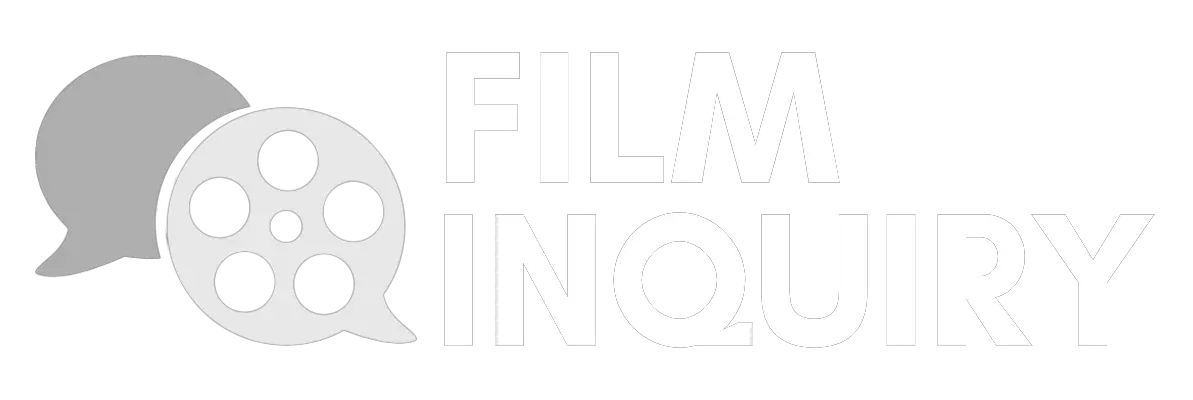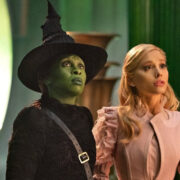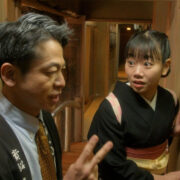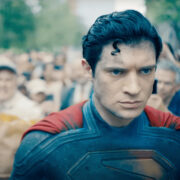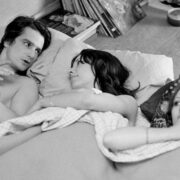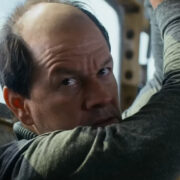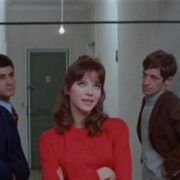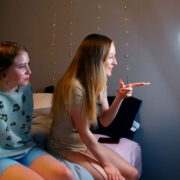WICKED: What A Load Of Shiz

Film critic, Ithaca College and University of St Andrews graduate,…
Rewatching Singin’ in the Rain, arguably the greatest Hollywood musical ever made, my wife and I talked about how we wish Hollywood made more big-budget movie musicals. And the flying monkey’s paw curled, and Jon M. Chu and Universal Pictures gave us Wicked, one of the most garish, overproduced, overlong, and expensive movies ever made — musical or otherwise.
Wicked — wisely not marketed with its actual title, Wicked: Part 1 — has earned many fans and admirers, including lots of critics. No shade to the people who think this is a good movie — and there are many, just check our critics’ Top 10 lists — but have they seen a Golden Age musical recently? Something with consistent and interesting production design and real choreography, where movie stars feel like movie stars and the camera actually holds on someone for an extended tap-dancing number? Even The Wizard of Oz, a twee and lighthearted movie that feels made to fall asleep to on a Saturday afternoon, has some lovely sets, gorgeously painted backdrops, and memorable, full-bodied songs. It’s better than Wicked by a Yellow Brick Road mile.
Is Wicked This Bad On-Stage?
Movie adaptations of stage musicals are funny little creatures. Fans of the original musical, audiences and critics alike, will likely judge the film’s merits based on how well it adapts the stage production. By such metrics, Wicked is likely a movie of outstanding quality, as it adapts nearly every aspect of the stage musical to the screen with, I’m assured, great care and reverence for the original production.
I don’t much care for the Broadway show. I was averse to Wicked from the moment I learned that the plot is basically just some guy’s fanfiction about “what if the Wicked Witch and Glinda the Good were pals once?” The show struck me as the ultimate exercise in missing the point, inventing a fleshed-out world for a flat children’s fairytale setting from 100 years ago that didn’t need any more complexity or lore. The point of the original story was that Oz is an allegory for Dorothy to adventure through, and it’s even implied by the end of The Wizard of Oz that it’s a land that only exists in Dorothy’s dreams, anyway. Oz doesn’t need to have schools or currency or racism because it’s a fairy-tale fantasy dreamworld. But don’t tell the guy who wrote Wicked that. Metaphors are for squares when there’s money to be made.
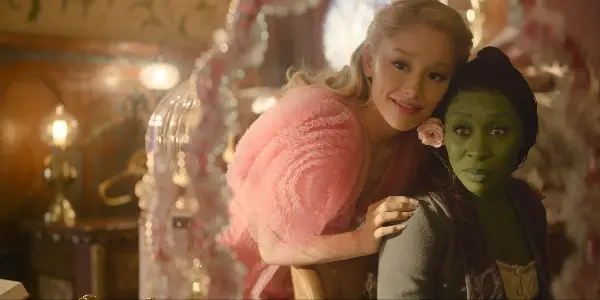
Since the Broadway show was such a huge hit, it was inevitable that a film would be made at some point. If only that happened while Idina Menzel and Kristen Chenoweth could have still believably played the main roles. But while Wicked is an enormously — say it with me — popular show, I felt like I was experiencing whiplash every time I saw a trailer for the film. Not since the ads for Dear Evan Hansen have I so frequently said “THAT’S what this show is about?!!” I had no idea that Wicked was a magical college story à la Harry Potter, or that it was about animal rights, or that its characters treated talking animals like minorities and that Elphaba (Cynthia Erivo) opposed anti-animal discrimination like a green, flying Malcolm X — just like I had no idea Dear Evan Hansen was about a 40-year-old man pretending to be a high schooler who’s so desperate to have sex with a teenager that he lies about being best friends with her brother who just killed himself. I always imagined Dear Evan Hansen was about a school shooting. You really do learn something new every day.
The Songs In Wicked Are Kind Of Bad
Wicked the film can blame many of its problems on Wicked the musical. It’s just not a very good musical, I’m afraid, having seen the film adaptation of only half of it. Perhaps things like the choreography and production design are better on a Broadway stage, but the songs and book leave a lot to be desired. Several of the musical’s biggest numbers — “Dancing Through Life,” “The Wizard and I,” and “Defying Gravity” — have a real stop-and-start momentum to them. They take ages to get going — it takes a full two minutes to get to the chorus in “Defying Gravity” — and when the songs finally get there, they then start all the way back at square one and slog through a downbeat verse or two or six before getting back to the chorus, like a sputtering jalopy. “Defying Gravity” in particular has so many brake-checks, especially for story beats woven haphazardly into the song, that it’s nearly impossible to vibe with what’s meant to be an exciting, vibrant, empowering number.
My least favourite song in the film is “No One Mourns the Wicked,” the barnstormer that starts off the show. It’s a dull and sanctimonious number for what’s supposed to be a scene of celebration. Its power-ballad high notes feel lifeless, unmotivated, and forced, and the way Chu stages it — with hateful posters of the Wicked Witch around the town square and the Munchkins burning an effigy of her — is just symbolic overkill, as if he didn’t trust the song and dialogue to convey that Elphaba’s supposed to be the villain.
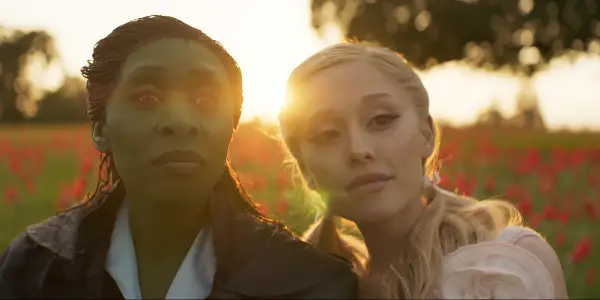
In nearly every number, I found John Powell and Stephen Schwartz’s music supremely irritating. That twinkly ’80s synth backing doesn’t do the singing any favors, and as a result most of these songs sound incredibly dated. Then there’s “The Wizard and I,” a lifeless “I want” song that feels completely perfunctory within the narrative. It’s also the only song Michelle Yeoh sings on, and… yikes. I love Yeoh, but she’s woefully miscast in this musical. She just cannot sing, not in this show and not with this music anyway; her limp and dry performance makes Russell Crowe’s turn in Les Misérables look like a Tony-winning role by comparison.
Ariana Grande Is Outstanding As Glinda
The only bright spots in this musical soup are “What Is This Feeling” and “Popular.” Unsurprisingly, those are the two songs that foreground Ariana Grande. If Erivo’s Elphaba is the heart of the film, Grande‘s performance as G(a)linda the Good is the energy the movie needs to sustain itself. Her character is dynamic and contradictory and ultimately interesting in a way that even Elphaba isn’t.
It took me about an hour to come around to Grande’s performance, mostly because her flat makeup and the terrible lighting make her look ghastly marshmallow-pale. But by the time she’s swimming across the floor in “Popular,” I was fully on board the Ariana Grande train. You can tell that the nerdy theater girl at her core is giddy with excitement every second of this movie, and Grande’s brand of pick-me girl energy, mixed with her pop star glamor, makes Glinda sparkle. It’s a real shame that almost everything else in the movie, from the makeup and the lighting to the washed-out costumes and inane direction choices, feel like they’re actively working against her.
Wicked Is A Monumentally Ugly Film
Every shot and set and costume in Wicked is uniquely dreadful and awful. The movie is the epitome of “Design Design,” a school of design lambasted by Reddit for the ways in which it uses maximalist but functionally useless designs that call attention to themselves. Like transparent partitions dividing urinals. Or a QR code shaped like a beer that no phone is actually capable of scanning. In Wicked, none of the production design, costume, or hair and makeup decisions make sense from a story perspective and aren’t motivated by anything other than a willful disregard of anything that isn’t what’s going to look cool on camera.
For example, how the fuck does that library work? The books are just going to fall out when the bookcase rotates. And you access them by stepping on other books?
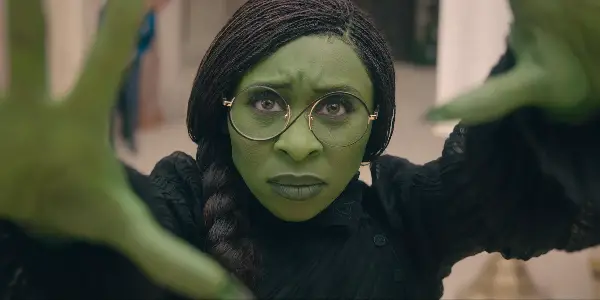
The school uniforms don’t make any logical sense — each uniform has the same two or three colours, yet the designs vary wildly from student to student. Isn’t the point of a uniform that everyone looks the same? Did every student make their uniforms from scratch?
No part of Cynthia Erivo‘s glasses touch her face. Her broom is a tangled, knobby mass of vines that would be super uncomfortable to sit on. Half a hexagon is a terribly impractical shape for a book. The list goes on.
Adding to the ugly design, Wicked’s cinematography, especially its lighting, is so basic and underwhelming. In keeping with Chu’s other visually uninventive work, the costumes and the actors do all the heavy lifting in Wicked, and none of the camera placements or blocking try to tell us anything about the characters or their world. The only interesting shot in the film is the flying-monkeys sequence at the beginning, and that was probably entirely done in a computer. That the lighting washes out all of the daytime scenes is a huge problem — take the library scene, for instance, when Jonathan Bailey sings “Dancing Through Life.” The windows around the library have intense light blasting through them, which washes out the backgrounds, and since there’s no strong key lighting on Bailey or the other actors, the folks in the foreground are always underlit and don’t stand out.
The “Dancing Through Life” scene represents a confluence of issues that plague the whole movie. The set design doesn’t make any sense, the choreography isn’t memorable or particularly well-staged, and Chu doesn’t let the camera simply rest on a dancer long enough to appreciate any of it. Just imagine what Fred Astaire or Gene Kelly could’ve done if you gave them that rotating library set. You would’ve gotten one dancer, a couple of pretty locked-down camera placements, and probably 10 minutes of one of the best goddamn dances you’ve ever seen in your life. In Wicked, you get a bunch of backup dancers doing splits on the shelves in the background and an edit that cuts around so much, you can’t even tell what steps the dancers are doing in the foreground. Bailey’s outsized and sensual performance is perfect, and he really nails the vocals for this number, but it’s shot in the most pedestrian manner when what it’s really begging for is the kind of heroic campiness that Chris Pine got in Into the Woods.

Chu just isn’t an expressive filmmaker, and judging solely by Wicked, I don’t think he’s capable of directing a good musical. That lack of artistic flair is most telling in the finale, when a sequence of Elphaba soaring around with her broomstick feels like a bunch of Marvel superhero shots. Erivo looks like such an alien in that final number, because the broom shots look completely different from everything else in the film. They felt like they were shot on a GoPro.
Chu is a filmmaker who knows how to make something look expensive rather than good, a trait that was invaluable with Crazy Rich Asians but has held him back ever since. When you look at any individual shot in Wicked, you see the money on the screen rather than any creative passion. There’s an army of production designers, painters, carpenters, and greenspeople listed in the end credits, but none of that work is visible in the final product — mostly due, again, to the terrible lighting and the blasé camerawork. If you told me that every set in the film is CGI and that the actors worked only on green-screens, I’d believe you. The film’s entire garish, expensive, fake aesthetic seems inspired by the visual noise of the pod race scene from Star Wars: Episode I — The Phantom Menace.
Conclusion
This thing cost $150 million, and every penny is up there on the screen — but it doesn’t have anything to say. It’s indicative of the era in which the Broadway show was produced — the biggest Broadway hits of the 2000s were stuff like Phantom of the Opera, Cats, and The Lion King, shows that exhibit empty, familiar spectacle and don’t ask anything of their audience. Wicked tries to make some political statements, about racism, the rise of fascism, and political scapegoating (with a literal talking goat). It has a scene where ICE shows up at Shiz University and arrests the goat professor. But I don’t think Chu’s garish, overegged production is fooling anybody into thinking it’s a political work.
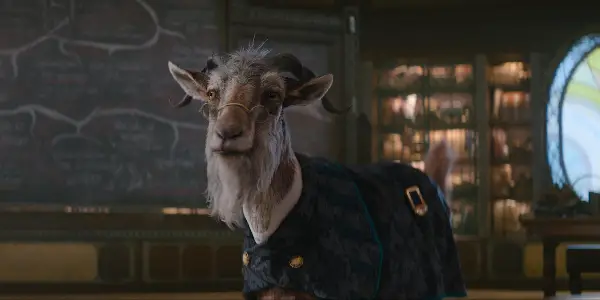
Instead, I hope we’ll remember Wicked as a banner child of everything wrong with 2020s Hollywood. It’s a creatively vacant, overly expensive work cashing in on easy nostalgia for the 1939 film while also having the gall to split itself into two parts. Part one of Wicked is longer than the original Wizard of Oz film, and it’s only half the story. I’ll begrudgingly see the second part when it comes out, mostly for Ariana Grande. I hope the realistic CG goat professor comes back. I hope he throws the first brick at Goat Stonewall or whatever happens in part two.
Wicked is currently showing in theaters and available to rent at home.
Does content like this matter to you?
Become a Member and support film journalism. Unlock access to all of Film Inquiry`s great articles. Join a community of like-minded readers who are passionate about cinema - get access to our private members Network, give back to independent filmmakers, and more.
Film critic, Ithaca College and University of St Andrews graduate, head of the "Paddington 2" fan club.
